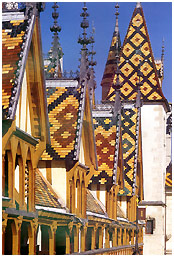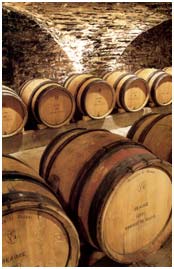The Hospices de Beaune
The Hôtel-Dieu was born on 4 August 1443. The Hundred Years War had recently been brought to an end by the signing of the Treaty of Arras in 1435. The massacres, however, continued and the "écorcheurs" ("skinners") were still roaming the countryside, pillaging and destroying, provoking misery and famine. The majority of the people of Beaune were declared destitute.
Nicolas Rolin, Chancellor of the Duke of Burgundy Philippe le Bon, and his wife Guigone de Salins reacted by deciding to create a hospital for the poor.
The hospital received its first patient on 1 January 1452. Elderly, disabled, orphans, sick people, women about to give birth, the destitute were all received and treated from the Middle Ages through to the 20th century. The hospital Sisters dispensed their care without cease. For centuries, they remained the very essence of the Hôtel-Dieu.
Throughout all this time, the hospital radiated outwards and federated other establishments in Pommard, Nolay, Meursault and Beaune to constitute a veritable community which became known as the Hospices de Beaune.
One of the unique characteristics of the Hospices Civils de Beaune is their wine producing estate.
All French hospitals are generally the owners of farms, buildings, heath land or forests, which do not generally provide much in the way of income. Sometimes these properties may even cost more than they bring in.
The Beaune institution, thanks to the donations and legacies which have been made throughout its history, is the owner of more than 60 hectares (150 acres) of vines.
Most of these vineyard plots are located in prestigious appellations. They are nearly all first growths and great growths.
The sale by auction of the wines of the Hospices de Beaune remains the most famous annual charity event in the world and all the professionals await it expectantly. In fact, this ceremony determines to some extent the quality and value of the year's harvest for the whole of Burgundy.
Internet site |
 |
 |
 |
|

Depuis des siècles, moutarde et Dijon sont indissociables. C'est évidemment dans cette ville, où elle est née en 1756, que la marque Amora y a ouvert le Musée de la moutarde .
De ses origines antiques à son industrialisation, de la graine de sénevé à la mise en pot, la moutarde est racontée, mise en spectacle, décortiquée.
C'est aussi l'histoire de la marque Amora, sa naissance, son ascension, son aventure publicitaire, que le Musée de la moutarde célèbre au travers de nombreux documents, illustrations et objets soigneusement archivés.
Musée Amora: 48 quai Nicolas Rolin 21000 Dijon.
Visites pour individuels:
- De mi-septembre à mi-juin: mercredi et samedi, à 15 heures.
- De mi-juin à mi-septembre: tous les jours, sauf dimanche et jours fériés,
à 15 heures.
Visites pour groupes:
Tous les jours de l'année sauf jours fériés.
Réservations auprès de l'Office du Tourisme de Dijon:
Tél: 03 80 44 11 41 Fax: 03 80 30 90 02
site internet |

"Château Georges" is located at St Loup Géanges, from 10 Km of Beaune.
